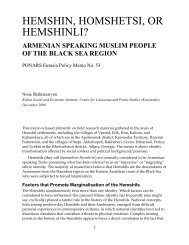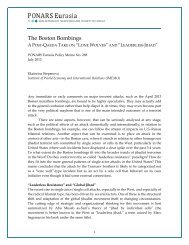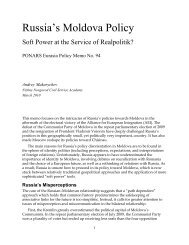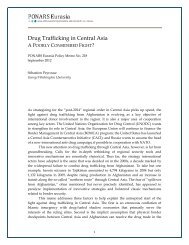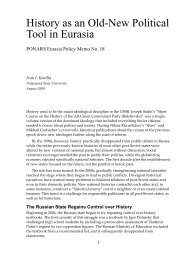The Chinese are Coming: Public Opinion and Threat Perception in ...
The Chinese are Coming: Public Opinion and Threat Perception in ...
The Chinese are Coming: Public Opinion and Threat Perception in ...
Create successful ePaper yourself
Turn your PDF publications into a flip-book with our unique Google optimized e-Paper software.
"<strong>The</strong> <strong>Ch<strong>in</strong>ese</strong> <strong>are</strong> <strong>Com<strong>in</strong>g</strong>: <strong>Public</strong> <strong>Op<strong>in</strong>ion</strong> <strong>and</strong><br />
<strong>Threat</strong> <strong>Perception</strong> <strong>in</strong> the Russian Far East<br />
Mikhail Alexseev<br />
January 2001<br />
PONARS Policy Memo 184<br />
San Diego State University<br />
<strong>Perception</strong>s Matter: Sens<strong>in</strong>g a Swell<strong>in</strong>g Wave of <strong>Ch<strong>in</strong>ese</strong> Migration<br />
Unpublished data from the passport <strong>and</strong> visa registration service of Primorsky krai,<br />
<strong>in</strong>terdepartmental memos from the Pacific Regional Directorate of the Russian Federal<br />
Border Service, <strong>and</strong> this author's <strong>in</strong>terviews with the chief of Primorsky krai Migration<br />
Service together suggest that the number of <strong>Ch<strong>in</strong>ese</strong> migrants <strong>in</strong> Primorsky krai at best<br />
amounts to approximately 1-1.5% of the local Russian population on any given day. <strong>The</strong><br />
actual number of <strong>Ch<strong>in</strong>ese</strong> migrants cannot be significantly higher. Putt<strong>in</strong>g Russian<br />
statistical data <strong>and</strong> official statements to test, this author conducted systematic visual<br />
observations on four trips to Primorsky krai (Primor'e) <strong>in</strong> 1999 <strong>and</strong> 2000 <strong>and</strong> found no<br />
evidence of <strong>Ch<strong>in</strong>ese</strong> presence that would be even remotely similar to the <strong>Ch<strong>in</strong>ese</strong><br />
presence <strong>in</strong> New York, San Francisco, or even Moscow.<br />
Yet an op<strong>in</strong>ion survey designed by this author <strong>and</strong> conducted <strong>in</strong> September 2000 by the<br />
Center for the Study of <strong>Public</strong> <strong>Op<strong>in</strong>ion</strong> at the Vladivostok Institute of History,<br />
Ethnography <strong>and</strong> Archaeology of the Russian Academy of Sciences shows that local<br />
Russians significantly overestimate the scale of <strong>Ch<strong>in</strong>ese</strong> presence <strong>in</strong> Primor'e. <strong>The</strong> survey<br />
(described on page 5) <strong>in</strong>cluded 1010 respondents selected r<strong>and</strong>omly from six locations<br />
with<strong>in</strong> Primorsky krai. When asked what proportion of the Primorsky krai population was<br />
<strong>Ch<strong>in</strong>ese</strong>, 46% of respondents (not <strong>in</strong>clud<strong>in</strong>g the "don't knows") said this proportion<br />
amounted to 10-20% (the modal response). Look<strong>in</strong>g to the future, most respondents<br />
(41%) said the proportion of ethnic <strong>Ch<strong>in</strong>ese</strong> would grow to 20-40% <strong>in</strong> 5-10 years, while<br />
another 20% said it would become 40-60%. Moreover, this survey reveals a strong<br />
perception that <strong>Ch<strong>in</strong>ese</strong> migration <strong>in</strong> Russia's southernmost Pacific prov<strong>in</strong>ce is much<br />
more likely to <strong>in</strong>crease than to stay the same or decl<strong>in</strong>e <strong>in</strong> the next 20 years. For example,<br />
respondents who estimated that at present up to 5% of the local population was <strong>Ch<strong>in</strong>ese</strong><br />
<strong>are</strong> most likely to believe that 10-20% of the local population would be <strong>Ch<strong>in</strong>ese</strong> <strong>in</strong> 5-10<br />
years. <strong>The</strong> same holds for those who said this proportion would be 10-20% <strong>in</strong> 5-10 years,<br />
<strong>and</strong> then rise to 20-40% <strong>in</strong> 10-20 years. Figure 1 graphically illustrates this prevail<strong>in</strong>g<br />
perception that <strong>Ch<strong>in</strong>ese</strong> migrants will keep com<strong>in</strong>g like a swell<strong>in</strong>g tidal wave.
Program on New Approaches to Russian Security<br />
Alexseev<br />
Are <strong>Ch<strong>in</strong>ese</strong> Migrants a <strong>Threat</strong>?<br />
In general, most respondents (about 40%) said that <strong>Ch<strong>in</strong>ese</strong> migrants posed no or very<br />
little threat to Russia as a whole, although close to one third of respondents see this<br />
migration as a strong threat. However, the largest proportion of respondents believes that<br />
<strong>Ch<strong>in</strong>ese</strong> migrants pose a strong or very strong threat to the Russian Far East <strong>and</strong> to<br />
Primorsky krai (43 <strong>and</strong> 55% respectively). At the same time, most of Primor'e's residents<br />
(42% of respondents) appear to believe that despite a threat to Primorsky krai, <strong>Ch<strong>in</strong>ese</strong><br />
migrants posed no threat whatsoever to them personally.<br />
Insecurity perceptions <strong>are</strong> manifest <strong>in</strong> a widely held view <strong>in</strong> Primor'e that Ch<strong>in</strong>a is<br />
nurs<strong>in</strong>g territorial claims on the Russian Far East. Exclud<strong>in</strong>g the "don't knows," almost<br />
82% of those polled say the <strong>Ch<strong>in</strong>ese</strong> see Primorsky krai as historically belong<strong>in</strong>g to<br />
Ch<strong>in</strong>a, <strong>and</strong> 74% of respondents feel that Ch<strong>in</strong>a will, <strong>in</strong> the long run, annex Primorsky krai<br />
or parts of it. <strong>The</strong> perception of a <strong>Ch<strong>in</strong>ese</strong> takeover threat also fits <strong>in</strong>to a "tidal wave"<br />
pattern similar to the perception of <strong>in</strong>creas<strong>in</strong>g migration. For example, most respondents<br />
believe that military clashes with Ch<strong>in</strong>a over border territories--such as the one at<br />
Damanski Isl<strong>and</strong> <strong>in</strong> March 1969--<strong>are</strong> unlikely at present. In the next 5-10 <strong>and</strong> 10-20<br />
years, however, they see such military conflicts as more likely than not (Fig. 2). <strong>The</strong><br />
future is rather dark for Primor'e residents--the more they look ahead, the greater their<br />
anticipation of hostile actions by Ch<strong>in</strong>a amidst <strong>in</strong>creas<strong>in</strong>g uncerta<strong>in</strong>ty.<br />
2
Program on New Approaches to Russian Security<br />
Alexseev<br />
<strong>The</strong>se perceptions appear paradoxical s<strong>in</strong>ce about three times as many respondents see<br />
<strong>in</strong>terstate relations between Russia <strong>and</strong> Ch<strong>in</strong>a as positive than as negative, now <strong>and</strong> 20<br />
years <strong>in</strong>to the future. In this regard, they see no threaten<strong>in</strong>g tidal waves, but rather a calm<br />
sea of good <strong>in</strong>tentions. Also, over the same time horizon, most Primor'e residents believe<br />
that the balance of military power will favor Russia over Ch<strong>in</strong>a. <strong>The</strong>n why would<br />
respondents feel <strong>in</strong>secure?<br />
Sources of Insecurity<br />
• Most respondents do not associate the military power balance between Russia <strong>and</strong><br />
Ch<strong>in</strong>a with the likelihood of <strong>Ch<strong>in</strong>ese</strong> takeover of Russian territories <strong>in</strong> the Far<br />
East (the statistical correlation is <strong>in</strong>significant <strong>and</strong> close to zero). Of those who<br />
said Primorsky krai or parts of it would be taken over by Ch<strong>in</strong>a, only 19% said<br />
this would happen through the use of force.<br />
• Relations between Moscow <strong>and</strong> Beij<strong>in</strong>g <strong>are</strong>, <strong>in</strong> fact, <strong>in</strong>versely related to threat<br />
perception: 25% of respondents <strong>in</strong> the group (those who believe Primorsky krai<br />
will be taken over by Ch<strong>in</strong>a) feel that Moscow is simply likely to negotiate<br />
Primor'e away. This perception is consistent with the message of Governor<br />
Nazdratenko's campaigns throughout most of the 1990s, <strong>in</strong> which he persistently<br />
accused Moscow of neglect<strong>in</strong>g Russian <strong>in</strong>terests <strong>in</strong> the Far East.<br />
• From among 57% of respondents <strong>in</strong> the sample who see <strong>Ch<strong>in</strong>ese</strong> takeover as<br />
imm<strong>in</strong>ent, 56% believe the ma<strong>in</strong> threat comes from seem<strong>in</strong>gly mundane, rout<strong>in</strong>e<br />
activities of <strong>Ch<strong>in</strong>ese</strong> nationals <strong>in</strong> Primor'e, such as work, trade, tourism, <strong>and</strong><br />
marriages. In a sense, this logic can be described as a "demographic security<br />
dilemma." A local Russian respondent who fears that through these rout<strong>in</strong>e<br />
activities the ethnic <strong>Ch<strong>in</strong>ese</strong> would settle down, start families, have children <strong>and</strong><br />
<strong>in</strong>vite friends <strong>and</strong> relatives over from across the border could never be certa<strong>in</strong><br />
whether the real <strong>in</strong>tentions of <strong>Ch<strong>in</strong>ese</strong> migrants <strong>in</strong> the <strong>are</strong>a <strong>are</strong> offensive or<br />
3
Program on New Approaches to Russian Security<br />
Alexseev<br />
cooperative. With the worst case scenario haunt<strong>in</strong>g one's views, <strong>in</strong>security<br />
perceptions can quickly spiral out of control, as bad <strong>in</strong>tentions <strong>are</strong> more likely to<br />
be ascribed to good ones than the other way round.<br />
• Ethnic stereotypes therefore play a large part <strong>in</strong> perceptions of security. In my<br />
survey, the Russians <strong>in</strong> Primor'e appear to view <strong>Ch<strong>in</strong>ese</strong> migrants as distant,<br />
socially undesirable, <strong>and</strong> fiercely protective of their cultural values. Asked about<br />
stereotypes contrast<strong>in</strong>g <strong>Ch<strong>in</strong>ese</strong> migrants from Russians, twice as many<br />
respondents saw the <strong>Ch<strong>in</strong>ese</strong> <strong>are</strong> more hardwork<strong>in</strong>g, entrepreneurial, <strong>and</strong> greedy;<br />
three times as many respondents saw them as more sly; <strong>and</strong> almost 20 times more<br />
respondents saw them as less generous than ethnic Russians. Moreover, 56% of<br />
respondents disapprove of their relatives marry<strong>in</strong>g <strong>Ch<strong>in</strong>ese</strong> citizens <strong>and</strong> another<br />
50% believe that <strong>Ch<strong>in</strong>ese</strong> migrants <strong>in</strong> Primorsky krai cannot be assimilated (only<br />
4.7% of respondents approve of Russian-<strong>Ch<strong>in</strong>ese</strong> marriages). In other words, if<br />
<strong>Ch<strong>in</strong>ese</strong> migrants settle down <strong>in</strong> the <strong>are</strong>a, they will not play by local Russian rules<br />
but gradually impose their own way of life <strong>and</strong> will ask for autonomy <strong>and</strong><br />
protection from across their border. In fact, opposition to one's relatives marry<strong>in</strong>g<br />
<strong>Ch<strong>in</strong>ese</strong> citizens <strong>and</strong> support for complete closure of the Russian-<strong>Ch<strong>in</strong>ese</strong> border<br />
<strong>are</strong> closely related.<br />
• Insecurity is also likely to arise out of perceptions of economic uncerta<strong>in</strong>ty <strong>and</strong><br />
relative deprivation. Thus, <strong>in</strong> the survey, respondents seem to have mixed views<br />
of the economic impact of <strong>Ch<strong>in</strong>ese</strong> migrants (see Table 1 on page 5), giv<strong>in</strong>g<br />
grounds for perceptions of uncerta<strong>in</strong>ty. On the one h<strong>and</strong>, the respondents see<br />
<strong>Ch<strong>in</strong>ese</strong> migration as predom<strong>in</strong>antly beneficial to agriculture, trade, availability of<br />
consumer goods, <strong>and</strong> the budget. <strong>The</strong>y also see the economic activities of <strong>Ch<strong>in</strong>ese</strong><br />
migrants as help<strong>in</strong>g to reduce prices. On the other h<strong>and</strong>, the same respondents<br />
associate the <strong>Ch<strong>in</strong>ese</strong> presence with more harm than good when it comes to local<br />
<strong>in</strong>dustry, job availability, the environment, <strong>and</strong> crime. Most respondents,<br />
however, feel that the <strong>Ch<strong>in</strong>ese</strong> <strong>are</strong> the ones receiv<strong>in</strong>g the net benefits of these<br />
exchanges. If any Russians <strong>are</strong> to benefit, respondents believe, they <strong>are</strong> mostly<br />
likely to be smugglers. This is how Primor'e residents evaluate the relative ga<strong>in</strong>s<br />
of the ma<strong>in</strong> actors <strong>in</strong> cross-border trade with Ch<strong>in</strong>a:<br />
4
Program on New Approaches to Russian Security<br />
Alexseev<br />
In other words, Russian respondents feel that the benefits of economic exchanges with<br />
Ch<strong>in</strong>a disproportionately benefit <strong>Ch<strong>in</strong>ese</strong> citizens <strong>and</strong> the <strong>Ch<strong>in</strong>ese</strong> government, plus a<br />
small group of smugglers on both sides. <strong>The</strong> majority of the local Russian public feels<br />
deprived relative to these groups.<br />
Respond<strong>in</strong>g to the <strong>Ch<strong>in</strong>ese</strong> Challenge<br />
In the survey, respondents were given 17 policy options on how to respond to <strong>Ch<strong>in</strong>ese</strong><br />
migration <strong>and</strong> asked to rank them on a scale of &endash;3 (most hostile) to +3 (most<br />
accommodat<strong>in</strong>g). For example, if someone felt the borders should be totally closed they<br />
would choose &endash;3, but if they favored totally open borders they'd chose +3. Those<br />
favor<strong>in</strong>g some <strong>in</strong>termediate measures would choose scores <strong>in</strong> between. <strong>The</strong> results reveal<br />
several trends:<br />
• Most respondents prefer hostile political <strong>and</strong> military measures to counter <strong>Ch<strong>in</strong>ese</strong><br />
migration. About 65% of respondents said they favor clos<strong>in</strong>g the border with<br />
Ch<strong>in</strong>a to cross<strong>in</strong>gs, <strong>in</strong>clud<strong>in</strong>g 25% who favored complete border closure. Less<br />
than 1%of respondents favored open<strong>in</strong>g the border completely. Approximately<br />
57% of respondents favor support<strong>in</strong>g the Cossacks or other voluntary paramilitary<br />
groups to ensure order <strong>in</strong> the face of <strong>Ch<strong>in</strong>ese</strong> migrants, <strong>and</strong> 70% of respondents<br />
came out aga<strong>in</strong>st Russia's arms sales to Ch<strong>in</strong>a. Deportation of illegal <strong>Ch<strong>in</strong>ese</strong><br />
migrants--which <strong>in</strong> practice means most of the migrant traders <strong>and</strong> workers <strong>in</strong><br />
Primor'e--was favored by 89% of respondents, <strong>and</strong> denial of permanent residence<br />
by 78%.<br />
• Primor'e residents <strong>are</strong> less hostile when it comes to economic measures <strong>in</strong><br />
response to <strong>Ch<strong>in</strong>ese</strong> migration. Hostility <strong>in</strong>creases if economic activity is<br />
associated with the migrants' proclivity to settle <strong>in</strong> the <strong>are</strong>a. Thus, 36% of<br />
respondents favor a ban on <strong>Ch<strong>in</strong>ese</strong> citizens trad<strong>in</strong>g <strong>in</strong> Primor'e (29% oppose such<br />
a ban), <strong>and</strong> only 27% of respondents favor rais<strong>in</strong>g taxes <strong>and</strong> duties on goods<br />
imported from Ch<strong>in</strong>a (36% oppose such raises). But when it comes to <strong>Ch<strong>in</strong>ese</strong><br />
citizens' right to l<strong>and</strong> ownership <strong>in</strong> Russia, 96% of respondents <strong>are</strong> aga<strong>in</strong>st it.<br />
Similarly, 60% of respondents want a ban on <strong>Ch<strong>in</strong>ese</strong> migrant labor, the latter<br />
be<strong>in</strong>g associated with longer presence of <strong>Ch<strong>in</strong>ese</strong> citizens <strong>in</strong> Primor'e, <strong>and</strong> hence<br />
greater proclivity for local settlement <strong>and</strong> marriage. At the same time, 64% of<br />
respondents favor development of cross-border tourism. Even though statistically<br />
tourism is the largest source of <strong>Ch<strong>in</strong>ese</strong> illegal migration <strong>in</strong> the region, the notion<br />
of tourism as a temporary <strong>and</strong> regulated activity is not l<strong>in</strong>ked with long-term stay<br />
<strong>and</strong> migrant settlement.<br />
• Primor'e residents oppose social accommodation of <strong>Ch<strong>in</strong>ese</strong> migrants <strong>in</strong> the <strong>are</strong>a:<br />
48% of respondents want to ban or never allow <strong>Ch<strong>in</strong>ese</strong>-language media, 42%<br />
prefer to ban or never allow <strong>in</strong>termarriages between Russians <strong>and</strong> <strong>Ch<strong>in</strong>ese</strong>, <strong>and</strong><br />
76% want to ban or never allow Ch<strong>in</strong>atowns <strong>in</strong> Primorsky krai.<br />
5
Program on New Approaches to Russian Security<br />
Alexseev<br />
• At the same time, regulated cultural exchanges with Ch<strong>in</strong>a <strong>are</strong> favored by most<br />
Primor'e residents <strong>in</strong> the survey (71%). About 56% of respondents support the<br />
idea of sett<strong>in</strong>g up <strong>Ch<strong>in</strong>ese</strong> cultural centers <strong>in</strong> the <strong>are</strong>a, <strong>and</strong> 62% favor <strong>in</strong>creas<strong>in</strong>g<br />
<strong>Ch<strong>in</strong>ese</strong> language <strong>in</strong>struction <strong>in</strong> the local schools.<br />
Implications for Security Policy<br />
<strong>The</strong>se responses suggest that while local residents have a reservoir of good will <strong>and</strong><br />
cultural <strong>in</strong>terest <strong>in</strong> Ch<strong>in</strong>a, perceptions of political, demographic <strong>and</strong> economic <strong>in</strong>security<br />
overwhelm such positive feel<strong>in</strong>gs. <strong>The</strong> data also shows how few <strong>Ch<strong>in</strong>ese</strong> migrants <strong>in</strong> the<br />
<strong>are</strong>a it takes to trigger powerful latent hostilities. <strong>The</strong> <strong>in</strong>terethnic tolerance threshold<br />
among the local Russians appears to be precariously low. Given exist<strong>in</strong>g demographic<br />
trends, which favor large-scale import of <strong>Ch<strong>in</strong>ese</strong> labor <strong>in</strong> the Russian Far East <strong>in</strong> the<br />
future, these attitudes po<strong>in</strong>t to the potential for violent conflict. However, the perception<br />
of economic benefits <strong>and</strong> the yearn<strong>in</strong>g for regulated cultural exchange suggest that there<br />
is a w<strong>in</strong>dow of opportunity to promote cooperative <strong>in</strong>terethnic relations <strong>in</strong> the <strong>are</strong>a<br />
(especially <strong>in</strong> the next 5 years). This is the opportunity for governmental <strong>and</strong> nongovernmental<br />
organizations to develop cross-cultural education opportunities <strong>and</strong> design<br />
public <strong>and</strong> private <strong>in</strong>stitutions to which both sides can take their grievances so as to<br />
diffuse disproportionately heightened perceptions of <strong>in</strong>security at the juncture of<br />
Eurasia's two largest powers.<br />
Survey Information:<br />
<strong>The</strong> sample was stratified by location (border vs. non-border), population change<br />
<strong>and</strong> population density, rural-urban population split, <strong>and</strong> economic <strong>in</strong>dicators<br />
6
Program on New Approaches to Russian Security<br />
Alexseev<br />
(average wage purchas<strong>in</strong>g power <strong>and</strong> trade with Ch<strong>in</strong>a). <strong>The</strong> <strong>are</strong>as <strong>in</strong>clude the cities<br />
of Vladivostok <strong>and</strong> Artem <strong>and</strong> the counties of Ussuriisk (<strong>in</strong>clud<strong>in</strong>g the city of<br />
Ussuriisk), Dalnerechensk, Khasan <strong>and</strong> Lazo. Vot<strong>in</strong>g districts served as primary<br />
sampl<strong>in</strong>g units (psus). In cities the psus were selected r<strong>and</strong>omly (by draw<strong>in</strong>g lots)<br />
<strong>and</strong> <strong>in</strong> rural <strong>are</strong>as where vot<strong>in</strong>g districts vary significantly <strong>in</strong> size, by r<strong>and</strong>om<br />
selection proportionate to estimated population size (a method which ensures<br />
r<strong>and</strong>om representation of small <strong>and</strong> large size psus without skew<strong>in</strong>g the sample<br />
toward either one or the other unit type). <strong>The</strong> number of dwell<strong>in</strong>gs <strong>in</strong> each psu was<br />
then counted <strong>and</strong> classified by type <strong>and</strong> proportions of residents <strong>in</strong> each psu by<br />
dwell<strong>in</strong>g type were estimated. Interviewers then selected the dwell<strong>in</strong>gs <strong>and</strong> the<br />
respondents r<strong>and</strong>omly by draw<strong>in</strong>g lots. This procedure improves on ROMIR <strong>and</strong><br />
VTsIOM sampl<strong>in</strong>g methods that <strong>are</strong> based on various types of quota sampl<strong>in</strong>g where<br />
<strong>in</strong>terviewers <strong>are</strong> allowed to choose respondents themselves. For more <strong>in</strong>formation,<br />
please contact the author.<br />
This memo is based upon research funded by the United States Institute of Peace <strong>and</strong> the Pacific Bas<strong>in</strong><br />
Research Center at the John F. Kennedy School of Government, Harvard University, with travel support<br />
provided by the International Research <strong>and</strong> Exchanges Board (IREX). <strong>The</strong> views presented <strong>in</strong> this<br />
publication <strong>are</strong> those of the author alone.<br />
© PONARS 1997<br />
7



